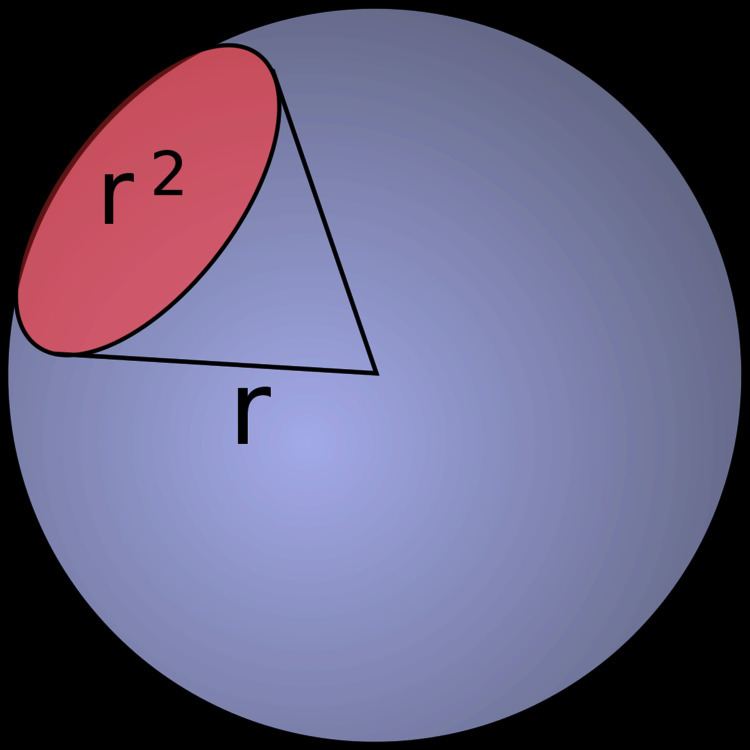Symbol ㏛ | Unit of Solid angle | |
 | ||
The steradian (symbol: sr) or square radian is the SI unit of solid angle. It is used in three-dimensional geometry, and is analogous to the radian which quantifies planar angles. The name is derived from the Greek stereos for "solid" and the Latin radius for "ray, beam".
Contents
The steradian, like the radian, is a dimensionless unit, essentially because a solid angle is the ratio between the area subtended and the square of its distance from the vertex: both the numerator and denominator of this ratio have dimension length squared (i.e. L2/L2 = 1, dimensionless). It is useful, however, to distinguish between dimensionless quantities of a different nature, so the symbol "sr" is used to indicate a solid angle. For example, radiant intensity can be measured in watts per steradian (W·sr−1). The steradian was formerly an SI supplementary unit, but this category was abolished in 1995 and the steradian is now considered an SI derived unit.
Definition
A steradian can be defined as the solid angle subtended at the center of a unit sphere by a unit area on its surface. For a general sphere of radius r, any portion of its surface with area A = r2 subtends one steradian.
The solid angle is related to the area it cuts out of a sphere:
whereBecause the surface area A of a sphere is 4πr2, the definition implies that a sphere measures 4π (≈ 12.56637) steradians. By the same argument, the maximum solid angle that can be subtended at any point is 4π sr.
Other properties
Since A = r2, it corresponds to the area of a spherical cap (A = 2πrh) (wherein h stands for the "height" of the cap), and the relationship h/r = 1/2π holds. Therefore one steradian corresponds to the plane (i.e. radian) angle of the cross-section of a simple cone subtending the plane angle 2θ, with θ given by:
This angle corresponds to the plane aperture angle of 2θ ≈ 1.144 rad or 65.54°.
A steradian is also equal to the spherical area of a polygon having an angle excess of 1 radian, to 1/4π of a complete sphere, or to (180/π)2 ≈ 3282.80635 square degrees.
The solid angle of a cone whose cross-section subtends the angle 2θ is:
Analogy to radians
In two dimensions, an angle is related to the length of the circular arc that it spans:
whereSimilarly in three dimensions, the solid angle is related to the area of the spherical surface that it spans:
whereFor example, a measurement of the width of a visible object would be given in radians. At the same time its visible area over one's visible field would be given in steradians. Just as the area of a circle is quadratically related to its diameter or radius, so is the area of the piece of a spherical surface cut out by a circular cone related to the angle across the piece. That area, or equivalently the proportion of a sphere its cone takes up, is a measure of three dimensional proportional volume, analogous to the two dimensional measure over the circle represented by an angle.
One-dimensional circular measure has units of radians or degrees, while two-dimensional spherical measure is expressed in steradians. In higher dimensional mathematical spaces, units for analogous solid angles have not been explicitly named. When they are used, they are dealt with by analogy with the circular or spherical cases. That is, as a proportion of the relevant unit hypersphere taken up by the generalized angle, or point set expressed in spherical coordinates.
SI multiples
A complete sphere subtends 4π ≈ 12.56637 steradians, so multiples larger than the decasteradian are rarely used.
Any range in excess of the whole area of a sphere would only be needed in conjunction with non-Euclidean, spherical geometry. Then it would also usually only be required in the context of nonlocal analysis. As such, solid angles over 4π are used exceedingly rarely in the literature.
